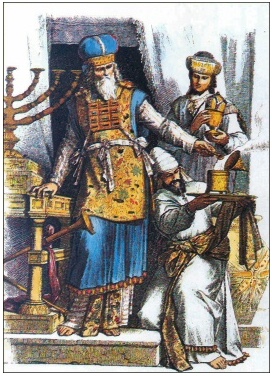
The Jewish High Priest and Jesus – Significance?
Understanding the history and background in the Old Testament of the priestly function prepares us to answer the questions, “What does it mean that Jesus is our High Priest? Why is this important?”
In the Old Testament from the time of Moses the priests were descendants of Levi. The Levites provided the priestly line and performed the priestly duties on behalf of all the people of Israel. Their duties were to minister at the altar, burn the sacrifices and teach the law (Deuteronomy 33:8-10; Hosea 4:1-10). In Israel, when the priesthood represented the nations’ relationship with God, the Levites served in a representative character for the whole nation in the matter of honor, privilege and obligation of priesthood. In their separated condition they maintained the nations’ covenant with God intact and they symbolized the purity and holiness that God required.
Their primary function was to maintain and assure, as well as reestablish, the holiness of the chosen people of God (Exodus 28:38; Leviticus10:7; Numbers 18:1). They mediated the covenant of God with Israel (Malachi 2:4; Numbers18:19; Jeremiah 33:20-26). They acted as judge imparting answers to legal questions (Exodus 33:7-11).In early Israel, an important function of the priests was to discover the will of God by means of the Ephod (I Samuel 23:6-12).
The priesthood was divided into three groups: 1) the high priest, 2) ordinary priests, and 3) the Levites. The Levites cared for the service of the sanctuary. The sons of Aaron, set apart for the special office of priest, could minister sacrifices at the altar. The highest level of priest, the high priest, represented bodily the height of the purity of the priesthood. He bore the names of all the tribes of Israel on his breastplate into the sanctuary, thus representing all the people before God (Exodus 28:29).
In the New Testament, the role of high priest continued especially the unique privilege of being the only one to enter the Holy of Holies once a year to offer sacrifice on the Day of Atonement. He also served as President of the Sanhedrin. Since there was no king during the first century A.D. the high priest was the principal agent for the people dealing with Rome. The role of high priest was political and religious. The high priesthood had lost its Old Testament hereditary character.
It was the High Priest who presided over the so-called trials of Jesus (Mark 14:53,60-64), of the early apostles (Acts 4:6; 5:17,21,27), of Stephan (Acts 7:1 and of Paul (Acts 23:2-5). The high priest also deputized the pre-Christian Saul to bring Christian Jews from Damascus to Jerusalem, to stand trial.
Now, consider why Jesus is called our High Priest.
The first time the title of HIgh Priest is applied to Jesus in the Bible occurs in Hebrews 2:17
“Therefore in all things He had to be made like His brethren that He might be a merciful and faithful High Priest in all things pertaining to God, to make propitiations for the sins of the people.”
The main audience of the book of Hebrews is the Jews who embraced Jesus Christ as their Messiah. They were trying to sort out what part of Judaism as a practicing religion carried over to the new order they were positioned in, having believed in Jesus as the Messiah. They were starting to be persecuted and confused, thinking maybe they should abandon their faith and lapse back into Judaism.
The writer of Hebrews used the figure of the high priest to illustrate in a familiar way just what Jesus’s death and resurrection meant for them. This is the significance of using the well known office of high priest to illustrate full-orbed that Jesus is their high priest.
Can you imagine making the connection that they no longer had to go through the high priest because now Jesus WAS their high priest?
“Therefore, since we have a great high priest who has ascended into heaven, Jesus the Son of God, let us hold firmly to the faith we profess. For we do not have a high priest who is unable to sympathize with our weaknesses, but we have one who has been tempted in every way, just as we are – yet he did not sin. Let us then approach the throne of grace with confidence, so that we may receive mercy and find grace to help us in our time of need” Hebrews 4:14-16
“…because Jesus lives forever, he has a permanent priesthood. Therefore he is able to save completely those who come to God through Him, because he lives to intercede for them. Such a high priest meets our need – one who is holy and blameless, pure, set apart from sinners, exalted above the heavens. Unlike the other high priests, he does not need to offer sacrifices day after day, first for his own sins and then for the sins of the people. He sacrificed once for all when he offered himself." Hebrews 7:25-27
The writer of Hebrews highlights through Jewish lenses the absolute sufficiency of Christ to save us, to intercede for us and to personally indwell us through His Spirit.
The significance of His being our high priest;
* No more sacrifices – Jesus offered Himslf once for all
* Having access to the Trinity in prayer
* Seeing how God completed in Christ what He instituted in Judaism
* Being interceded for daily 24/7 by Jesus, the Son of God, our High Priest
As we close consider …How is Jesus interceding for you right now?
Nelson Study Bible; Zondervan Pictorial Encyclopedia of the Bible, Merrill C. Tenney. General Editor, Volume 4 M-P;
Holman Bible Handbook, David S. Dockery, General Editor. Nashville, TN: Holman Bible Publishers, 1992. Page 161.



